 As I experienced the swirls and loops and fluid flow of ink from Wordsworth's pen, Bronté’s neat and spidery hand, Katherine Mansfield’s firm script in her Suburban Fairy tale, Angela Carter’s italic in her manuscript for Wise Children, the neat child-like hand of Lewis Carroll in his Alice’s Adventure Underground and the fat cursive letters of Virginia Woolf writing her newspaper as a child – it occurred to me that I’m becoming unused to deciphering and reading real handwriting. Will our children’s children lose this skill entirely?
As I experienced the swirls and loops and fluid flow of ink from Wordsworth's pen, Bronté’s neat and spidery hand, Katherine Mansfield’s firm script in her Suburban Fairy tale, Angela Carter’s italic in her manuscript for Wise Children, the neat child-like hand of Lewis Carroll in his Alice’s Adventure Underground and the fat cursive letters of Virginia Woolf writing her newspaper as a child – it occurred to me that I’m becoming unused to deciphering and reading real handwriting. Will our children’s children lose this skill entirely? Blog: Writing and Ruminating (Login to Add to MyJacketFlap)
JacketFlap tags: writing, wordsworth, austen, building a poetry collection, Add a tag
Georgetown alums will recognize the title of the post as being the source of the team name "hoyas". The phrase is Greek and Latin, traditionally rendered hoia saxa, and literally means "What rocks!" (Of all the Latin phrases I picked up at Georgetown Law, this nonlegal one really stuck.)
Looking out at the sunny day today here in the White Mountains of New Hampshire, I cannot help but think of Elizabeth Bennet's delight in Chapter 27 of Pride and Prejudice at being invited to accompany her aunt and uncle on a tour of England that might take them as far as the Lake District.
No scheme could have been more agreeable to Elizabeth, and her acceptance of the invitation was most ready and grateful. "My dear, dear aunt," she rapturously cried, "what delight! what felicity! You give me fresh life and vigour. Adieu to disappointment and spleen. What are men to rocks and mountains? Oh! what hours of transport we shall spend! And when we do return, it shall not be like other travellers, without being able to give one accurate idea of any thing. We will know where we have gone -- we will recollect what we have seen. Lakes, mountains, and rivers shall not be jumbled together in our imaginations; nor, when we attempt to describe any particular scene, will we begin quarrelling about its relative situation. Let our first effusions be less insupportable than those of the generality of travellers."And yes, I rather expect that Elizabeth's raptures about nature in conjunction with a mention of the Lake District are a nod to William Wordsworth, whose poem Lines Written a Few Miles Above Tintern Abbey, and in particular this effusively meditative (yes, probably an oxymoron) passage pulled from its fifth stanza, were well-known and appear to have been loved by Austen, given that she references this poem in other novels as well, including Mansfield Park:
The picture of the mind revives again:
While here I stand, not only with the sense
Of present pleasure, but with pleasing thoughts
That in this moment there is life and food
For future years. And so I dare to hope,
Though changed, no doubt, from what I was when first
I came among these hills; when like a roe
I bounded o'er the mountains, by the sides
Of the deep rivers, and the lonely streams,
Wherever nature led -more like a man
Flying from something that he dreads than one
Who sought the thing he loved. For nature then
(The coarser pleasures of my boyish days,
And their glad animal movements all gone by)
To me was all in all. -I cannot paint
What then I was. The sounding cataract
Haunted me like a passion; the tall rock,
The mountain, and the deep and gloomy wood,
Their colours and their forms, were then to me
An appetite; a feeling and a love,
That had no need of a remoter charm,
By thought supplied, nor any interest
Unborrowed from the eye. -That time is past,
And all its aching joys are now no more,
And all its dizzy raptures. Not for this
Faint I, nor mourn nor murmur; other gifts
Have followed; for such loss, I would believe,
Abundant recompense. For I have learned
To look on nature, not as in the hour
Of thoughtless youth; but hearing oftentimes
The still, sad music of humanity,
Nor harsh nor grating, though of ample power
To chasten and subdue. And I have felt
A presence that disturbs me with the joy
Of elevated thoughts; a sense sublime
Of something far more deeply interfused,
Whose dwelling is the light of setting suns,
And the round ocean and the living air,
And the blue sky, and in the mind of man:
A motion and a spirit, that impels
All thinking things, all objects of all thought,
And rolls through all things. Therefore am I still
A lover of the meadows and the woods,
And mountains; and of all that we behold
From this0 Comments on Hoya saxa! as of 1/1/1900Add a Comment
Blog: Writing and Ruminating (Login to Add to MyJacketFlap)
JacketFlap tags: analysis, national poetry month, building a poetry collection, poetry, wordsworth, Add a tag
Before I even hit "post" on yesterday's poem, "Home-Thoughts from Abroad" by Robert Browning, I knew that this was today's choice. Amazing that it took me until after dinner to get around to posting it, huh? But I spent the morning reading Volume II of Sense and Sensibility, and the afternoon on writing and errands, and the day got away from me. But I digress. The reason that I knew I wanted to post this poem today is because of Robert Browning's description of the yellow buttercups that so reminded him of April in England; today's poem also involves yellow flowers and memory.
Some of you may know this poem as "Daffodils", though that's not its actual name; its real name is "I Wandered Lonely as a Cloud", and it's an extremely popular, much-anthologized poem.
I Wandered Lonely as a Cloud
by William Wordsworth
I wandered lonely as a cloud
That floats on high o'er vales and hills,
When all at once I saw a crowd,
A host, of golden daffodils;
Beside the lake, beneath the trees,
Fluttering and dancing in the breeze.
Continuous as the stars that shine
And twinkle on the Milky Way,
They stretched in never-ending line
Along the margin of a bay:
Ten thousand saw I at a glance,
Tossing their heads in sprightly dance.
The waves beside them danced; but they
Out-did the sparkling waves in glee:
A poet could not but be gay,
In such a jocund company:
I gazed— and gazed— but little thought
What wealth the show to me had brought:
For oft, when on my couch I lie
In vacant or in pensive mood,
They flash upon that inward eye
Which is the bliss of solitude;
And then my heart with pleasure fills,
And dances with the daffodils.
Form: Each stanza has 6 lines, is written in iambic tetrameter (four iambic feet per line: taDUM taDUM taDUM taDUM), and has a rhyme scheme of ABABCC; this form, essentially an open form in "sixain" (six lines to a stanza), was first developed by Shakespeare in "Venus and Adonis", and was used by Wordsworth in this poem, written in 1804.
Discussion: If you read this one aloud, it is easy to fall into a "pause-at-the-end-of-each-line" mentality, as a means of emphasizing the rhyme scheme, but this is something you SHOULD NOT DO, because you will be lulled into a false sense of complacency by the rhythm and sing-song rhyme effect you achieve, and you will not truly hear the poem.
Here's the first stanza written out with pauses only where they naturally occur:
I wandered lonely as a cloud that floats on high o'er vales and hills,
When all at once I saw a crowd,
A host,
of golden daffodils;
Beside the lake,
beneath the trees,
Fluttering and dancing in the breeze.
If you go back and read the poem aloud, following the punctuation, you will be able to better hear what Wordsworth is saying. And while references to nature and use of metaphor are common devices in modern poetry, they are used in part because Wordsworth came along and wrote in the way that he did, with a reverence for and appreciation of nature, and with a focus on emotional response to nature and other stimuli. As a result, Wordsworth is widely credited as being one of the first poets in the Romantic era, along with his friend Coleridge, whose poems were included in the 1798 publication Lyrical Ballads, which I referenced in a now-old quoteskimming post.
Today's poem is one of the best-loved and most well-known in the English language, and that is with good reason: its imagery is lovely, its rhyme and metre make it easy to memorize, and the story it tells (of seeing some
Blog: jama rattigan's alphabet soup (Login to Add to MyJacketFlap)
JacketFlap tags: wordsworth, poetry and cake month, Add a tag
"All good poetry is the spontaneous overflow of powerful feelings." ~ Wordsworth, Preface to the Lyrical Ballads, 1802.
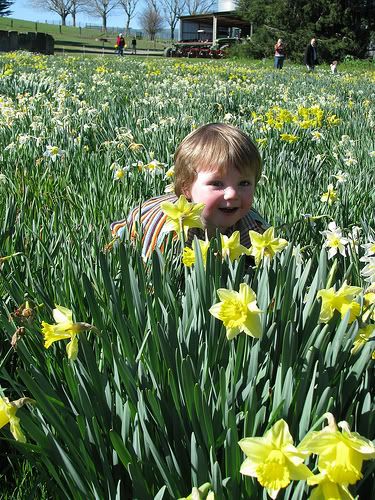
photo by heart felt
I've been seeing daffodils everywhere, so it truly must be Spring.
Though crocuses are usually the first to pop up at winter's end, it's those showy yellow daffodils, bobbing their heads in the breeze and trumpeting Spring's arrival, that makes it official.
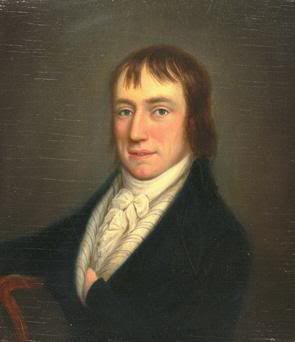
Wordsworth portrait by William Shuter, 1798
It just so happens that the man who wrote the most famous daffodil poem ever, William Wordsworth, is celebrating his 239th birthday today. You probably know him as the preeminent poet of England's Lake District, who, along with Samuel Taylor Coleridge, pretty much ignited the Romantic movement.
April must have been a good month for poems even back in the 19th century, because it was on April 15, 1802, that Wordsworth and his sister, Dorothy, visited a friend in Eusmere, and on their walk home to Grasmere, saw "a host of golden daffodils" along the shore of Ullswater. 
Ullswater is the second largest lake in the Lake District, considered by many
to be the most beautiful.
Dorothy recorded the experience in her diary, and it is widely believed this formed the basis for Wordsworth's most well known poem, "I Wandered Lonely as a Cloud," which he wrote two years later at Dove Cottage.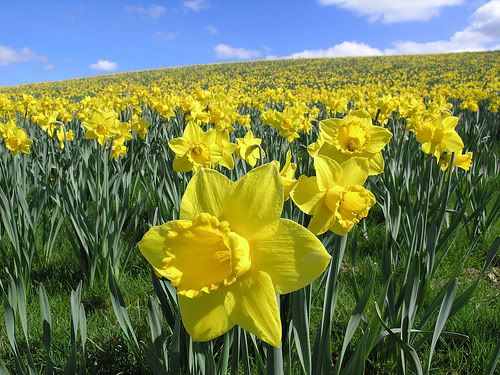
photo by Garry Platt
I first read the poem in high school, then studied Wordsworth in greater depth in college. Yes, I had read the requisite Chaucer, Milton, Shakespeare, Pope and Spenser, like any conscientious English major. But it wasn't until my class in the Romantics that I became wholly enamored with poetry.
Finally -- poetry that emphasized and valued the inner emotions of the poet, with diction that resembled natural speech! Poetry that focused on "incidents and situations from common life," that was colored by the imagination, "whereby ordinary things should be presented to the mind in an unusual way."
Yes! Enough of elevated language that placed the reader at a distance. Enough of archaic forms and structures that excluded readers rather than engaged them! Wordsworth's intent in writing poetry that spoke to the common man in his own language, a poetry of sincerity and passion rather than stilted artifice (as outlined in his Preface to the Lyrical Ballads), was, in some ways, a reaction against the adverse effects of urbanization, industrialization, mass media, and mass culture:
He attributed to imaginative literature the primary role in keeping the human beings who live in such societies emotionally alive and morally sensitive. Literature, that is, could keep humans essentially human. (Norton Anthology of English Literature, Vol. 2, Eighth Edition).
And in order to do this, poetry must be, above all things, accessible.
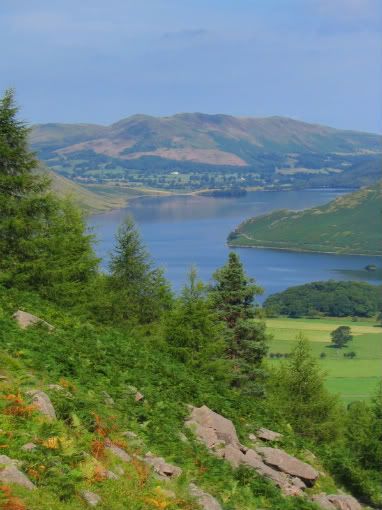
Another view of Ullswater.
"I Wandered Lonely as a Cloud" is much more than an iconic poem everybody knows or memorizes. In a small space of four stanzas, it encapsulates the essential elements of Wordsworth's new and experimental Romantic theory: simple language, a rustic setting, focus on the poet's emotional reaction to nature, the crucial role of the imagination in spawning "emotion recollected in tranquility," thereby validating the inherent power and resonance of instinctual, elemental sensibilities.
The fact that this poem is now largely part of our DNA, whether we claim to be poetry lovers or not, proves Wordsworth correct. The purest, truest human feelings have the best chance of being accurately conveyed in a language utilized by the common man.
While living in England years ago, I finally got to visit the Lake District for myself. It was definitely one of those "dreams-come-true" experiences. We saw Beatrix Potter's Hill Top Farm in Near Sawrey, and the spectacular ruins of Tintern Abbey. And then -- there was Dove Cottage itself, originally an inn called the Dove and Olive, preserved just as it was when Wordsworth, Dorothy, and his wife, Mary, lived there between 1799-1808. 
Dove Cottage (photo by Paul Tuna Turner)
As I stood on those flagstone floors and gazed at the dark paneling and white washed walls, I thought how miraculous it was, that a girl from Hawai'i who so loved this poet and once marked her textbooks with extensive marginalia and memorized countless lines, should now be there in the very house where he wrote his greatest poems, where his sister wrote her journals, where Coleridge and other leading figures of the day frequented almost 200 years before.
This experience alone made my long journey to England worth it. Book study is one thing, being there in person quite another. When I saw how the light filtered through the windows, how the air felt and smelled -- the poems I knew only from books finally came alive. The imagination that Wordsworth had time and again touted as man's supreme gift, has ever since enabled me to see, understand, and endure. 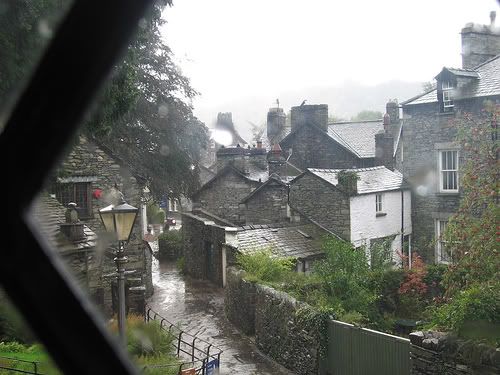
View from Dove Cottage (photo by Ichabod2)
Though today we might take for granted the value and privilege of individual creativity and innovative freedom, it is worth remembering those who challenged existing doctrines and through their innovations revolutionalized the poetical landscape. I am reminded of this every spring with the daffodils. How about you?
photo by Ennor
I WANDERED LONELY AS A CLOUD
by William Wordsworth
I wandered lonely as a cloud
That floats on high o'er vales and hills,
When all at once I saw a crowd,
A host, of golden daffodils;
Beside the lake, beneath the trees,
Fluttering and dancing in the breeze.
Continuous as the stars that shine
And twinkle on the milky way,
They stretched in never-ending line
Along the margin of a bay:
Ten thousand saw I at a glance,
Tossing their heads in sprightly dance.
The waves beside them danced; but they
Out-did the sparkling waves in glee:
A poet could not but be gay,
In such a jocund company:
I gazed - and gazed- but little thought
What wealth the show to me had brought:
For oft, when on my couch I lie
In vacant or in pensive mood,
They flash upon that inward eye
Which is the bliss of solitude;
And then my heart with pleasure fills,
And dances with the daffodils.
Happy Birthday, Mr. Wordsworth!
photo by abbietabbie
To read Dorothy's journal entry and hear a reading of the poem, click here.
Kelly Fineman has written numerous posts about Wordsworth. Read her excellent explication of "I Wandered Lonely as a Cloud," here, and her ruminations on "Ode: Intimations of Immortality From Recollections of Early Childhood," probably my favorite Wordsworth poem, here.
The Dove Cottage, Wordsworth Museum and Art Gallery has more interesting info on their website.
"Fill your paper with the breathings of your heart." ~ Wordsworth
Blog: Just One More Book Children's Book Podcast (Login to Add to MyJacketFlap)
JacketFlap tags: Family, Ages 0-3, Ages 4-8, Detailed, Creativity, Generosity, Picture book, Envy/Competition, childrens book, Fun, Boy, Humour, Assertiveness, Siblings, Writing, Language, Activity/Game, review, Podcast, boris kulikov, kate banks, maxs words, Add a tag
Author: Kate Banks Illustrator: Boris Kulikov Published: 2006 Farrar, Straus & Giroux ISBN: 0374399492 Chapters.ca Amazon.com Language leaps to life in this engaging story of competition, character and cultivating a thirst for words. Other books mentioned: Cherries and Cherry Pits Tags:boris kulikov, childrens book, kate banks, maxs words, Podcast, reviewboris kulikov, childrens book, kate banks, maxs words, Podcast, review




It sounds wonderful. Yet another reason to get myself up to London!
At the moment I'm enjoying the snowy landscapes of The Box of Delights...which I reckon must have been an influence on the snowy Buckinghamshire of The Dark is Rising decades later.
It IS wonderful Sue and worth a visit but needs time and energy. And I've never read The Box of Delights Emma but The Dark is Rising was another of those books where one has a sense of knowing the landscape before ever having set foot in it. I suppose growing up in another country has done this for me. When you see the landscape for the first time, you feel you've been there before in another life.
Last night I read a book by children's author Joan Lennon - one of her "Wickit Chronicles" and was bowled over by her descriptions of Ely and the fens.
Her hero goes punting around in the mist-covered marshes: "Away to the east the sun hung, still low in the sky, making everything spark and glint. The air was thin and bright and smelled of thin ice and the distant tang of the sea..." Wonderfully evocative (and a fantastic and very humorous adventure story).
Great description. Joan will be delighted with yr comment. She writes very amusing blogs too.
Great description. Joan will be delighted with yr comment. She writes very amusing blogs too.
Wow! Thanks so much Emma and Dianne! You've made my day!